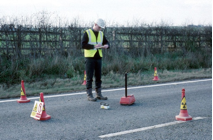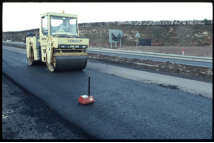pdf Road density gauge crushed by road roller (2.54 MB)
Description of the incident
A portable density gauge, belonging to a road construction company, was badly damaged when it was crushed by a road roller. This type of gauge, which incorporates a 370 MBq caesium 137 source and a 1.85 GBq americium/beryllium source is commonly used in road construction.
The gauge was left in the road whilst the operator discussed his work with a supervisor on the nearby footpath. The driver of the road roller did not see the gauge as he traversed the site. He was alerted to the situation by the gauge operator, but was unable to stop the roller in time. The operator cordoned off an area up to five metres around the damaged gauge and called for assistance.
The emergency services were alerted and the Police activated a national scheme for assistance in the event of incidents in public places. This led to a team of physicists from a local hospital being called to the scene. In the meantime, fire service personnel placed the damaged gauge in a skip which they then filled with sand.
The physicists surveyed the scene of the accident but found no residual contamination and concluded that the sources in the damaged gauge remained intact. The gauge, still in the skip, was then transported back to the company’s premises. The next day the Radiation Protection Adviser visited both the company’s premises and the scene of the accident. He carried out a thorough inspection at both locations and found no residual contamination. The gauge was removed for subsequent disposal.
The company involved in this incident was prosecuted by the national regulator and was ordered to pay approximately €15,000 in fines and costs.


2 - All users on site must be aware of the risks


4 - Sources capsules not damaged
Other Similar Incidents
There have been a number of similar incidents reported, for example:
1. A nuclear density gauge being used to carry out a series of measurements on a landfill site was badly damaged when it was crushed by a dump truck. The gauge was being supervised by the operator sitting in his van 2 metres away. The gauge handle was snapped off and the casing badly damaged. The operator immediately demarcated the area around the damaged gauge with cones and notified his Radiation Protection Supervisor. The Radiation Protection Adviser attended the scene and confirmed that the sources had not been ruptured and that the shielding remained in place. The damaged gauge was returned to the company’s radioactive source store in its normal transportation container and was subsequently disposed of via the supplier.
2. A nuclear density gauge was badly damaged when it was crushed under a road roller. It had been left on the road unsupervised ‘momentarily’ whilst the operator recorded results. The driver of the road roller did not see the gauge prior to it being crushed under the vehicle. The gauge broke into two pieces under the weight of the roller – one-half contained the gamma source, the other the neutron source. The gauge was being used in the ‘gamma backscatter’ mode at the time and the shutter remained open after the incident. Dose rates in excess of 2 mSv/h were later measured close to the unshielded gamma source.
Contrary to instructions in the company’s contingency plans, a tonne of crushed stone was tipped on the gauge and a controlled area was set up around the gauge using tapes and road cones. After a preliminary dose rate survey, the Radiation Protection Supervisor and the operator extracted the two halves from the crushed stone and placed them each inside two thick plastic bags. The Radiation Protection Adviser attended the scene and confirmed that the sources were not ruptured. The two halves of the gauge were stored in a locked cabin overnight, and returned to the company’s radioactive source store the following day using specialised transportation equipment. The gauge was subsequently disposed of via the supplier.
Following this incident, the company decided to use a flashing warning beacon next to the gauge whenever it was in use, to make it easier for drivers of large vehicles to see the gauge.
Radiological consequences
Despite the severe damage to these gauges, the source capsules remained intact and there was no risk of radioactive contamination.
None of the persons involved in the recovery of the gauges received a significant external radiation (gamma and neutron) dose.
Lessons to be learned
Operators of nuclear density gauges must be aware of their supervisory duties and not leave a gauge unattended unless it is securely stored in a building or vehicle. This is particularly important when large vehicles are in the vicinity.
Consideration should be given to temporarily demarcating an area around the gauge (eg with suitable labelled traffic cones or a flashing beacon), where the supervision of the operator is not considered sufficient to prevent incidents such as those above.
Other persons working on site, eg. drivers of large vehicles, should be made aware of the safe working procedures for working near to the gauge.
Damage to a gauge by a vehicle on a road construction site is a reasonably foreseeable occurrence and the employer’s contingency plans should have considered this. Operators must have received training in implementation of the contingency plans and also in the other safety requirements for the work (eg. source security).
If a nuclear density gauge is badly damaged, the integrity of both the shielding and the source capsules should be checked before the gauge is moved. The latter will require leakage tests (for radioactive contamination), which gauge operators are unlikely to be able to do themselves. Thus, employers should consider, in advance, how these arrangements will be put in place.
If a nuclear density gauge is badly damaged, it should not be immersed in material such sand or stones since this obstructs a proper assessment of the damage. It may in fact make the situation worse if a radioactive source is ruptured, ie because any material placed in contact with the gauge could become contaminated. Instead, the area around the gauge (2 metres is normally sufficient) should be demarcated and the gauge should not be touched until it has been examined and checked for leakage of radioactive material.



